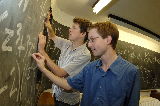Latest News
Maths Houses gain listed status
 Built between 1968 and 1969, the houses were built for the purpose of accommodating visiting mathematicians and their families attending symposia, workshops, etc. at the Mathematics Institute. Since then, they have been in regular use, even accommodating a former Vice-Chancellor, Clark Brundin, who lived there for a period of time.
Built between 1968 and 1969, the houses were built for the purpose of accommodating visiting mathematicians and their families attending symposia, workshops, etc. at the Mathematics Institute. Since then, they have been in regular use, even accommodating a former Vice-Chancellor, Clark Brundin, who lived there for a period of time.
MRC Houses were first proposed when Sir Christopher Zeeman made a grant application to the Nuffield Foundation. This application was approved, and gave the MRC the opportunity to build the MRC Houses, to appoint visiting Nuffield Professors, and to staff the Mathematics Research Centre (MRC).
The MRC Houses quickly became internationally known and a very important attraction for visitors to the various mathematics activities. The architect Bill Howell, of Howell, Killick, Partridge and Amis, with Sir Christopher Zeeman, began design work on the five houses and two flats in 1967. Working with the idea that the houses needed to provide both living space for families and study space where mathematicians could work undisturbed, the design included a study with blackboards running continuously around the curved walls. The blackboards were high enough for the mathematician to work on but also ‘low enough for small children to use the bottom bit’.
The five houses and two flats were all individually furnished by Sir Christopher Zeeman and his wife Lady Rosemary and the then MRC Manager, David Fowler and his wife Denise. Each house was uniquely furnished, and included one with antique furniture. Built during 1968 to 1969, and officially opened in June 1969 by then Vice-Chancellor Jack Butterworth, Sir Christopher Zeeman and Bill Howell, the houses won the RIBA (Royal Institute of British Architects) Architecture Award in 1970.
The MRC Houses have been in continuous use for their original purpose since they were opened and, with the Grade II* listed status, will continue to be for the foreseeable future.
